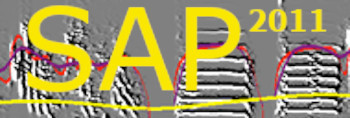Time course & mean values
| < PREVIOUS: Symmetric measurements_______________________________________ | > NEXT: Exploring similarity |
|
|
|
|
|
|
An example of time-course versus mean values comparison:
Above are similarity matrices of intervals of sounds from example1.wav and example2.wav. Note that although we did not change the threshold p-value, the sections are very different in shape and size. The time-course method gives narrower sections that capture the sequential (diagonal) match, whereas the mean-values method shows big blobs of similarity. In both cases we see that the top section is surrounded by a red rectangle, indicating that the final section is identical to the original similarity section. This is not the case with the bottom section. You can see how the original section (blue) was modified (red) so as to trim the redundancy with the top section -- which is also the superior one. It is superior in the sense that it explains more similarity even though its local score is lower. This is because multiplying the duration of the top section by its local score gives higher similarity than that of the lower section. That is, the algorithm takes into account the overall similarity explained by each section. Note also, that although the shape of the sections is very different, the oblique cuts through the sections are similar across methods, hence the overall score and the partial scores are very similar. You should examine the matrix shown in the combo button quite often, since it will help you understand what’s going on ‘behind the scenes’ of the similarity measurements. The white cross shown on top of some of the blue rectangles signifies that this section was excluded because of redundancy.

